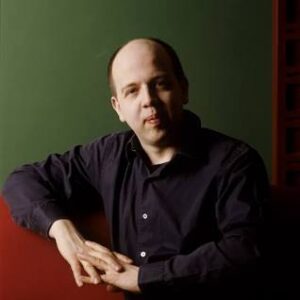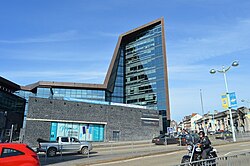MATHILDE MILWIDSKY, VIOLIN AND HUW WATKINS, PIANO
at the LEVINSKY HALL, PLYMOUTH UNIVERSITY, Saturday 11 th November 2023
Part of the Musica Viva series, which brings classical music to the Arts Institute for the benefit of
students and the wider community, this delightful concert was well-attended and received, as it
deserved to be. As always with these concerts the programme started with an introduction by both
musicians, telling us a little bit about the works they were to perform. Some of these helpful nuggets
of information I shall mention when writing about each piece. The programme was wide-ranging,
using works from Classical early Beethoven, Romantic Cesar Franck to twentieth century Vaughan-
Williams, Eugene Ysaye and Anton Webern. The contrasts of style and form were a wonderful
showpiece for the range and ability of both performers.

They started with the gorgeously emotional The Lark Ascending by Ralph Vaughan-Williams.
Milwidsky told us she had chosen it for the programme because the 11 th November was Armistice
Day and the piece, in the version they were performing it, had been composed at the beginning of
the First World War. After this war Vaughan-Williams reworked it for solo violin and in 1920 the first
orchestral version was delivered. The composer was inspired by George Meredith’s poem of the
same title, where the lark is described as producing ‘the silver chain of sound/ Of many links without
a break/ In chirrup, whistle, slur and slake.’ Later in the poem he describes how the song of the lark
descends into the valley below: ‘ and he the wine which overflows/ To lift us with him as he goes.’ That
extraordinary little bird, so high in the sky as to be almost invisible, pours down his song which, to
human ears, takes us up into the heavens.
This is indeed what happened as we heard the exquisite rendering of the violin, sometimes
carrying us upwards to ‘far and wee’ heights, sometimes plunging downwards, but always tender
and expressive, the piano echoing and colouring the music. The middle section broadens out with
chords that describe the pastoral scene before we return to the bird, his courage and determination,
the violin almost defiant as the lark disappears once more to impossible heights in an echo of the
beginning.
There is always an edge of sadness to this piece and it was indeed a fitting reminder of that
most terrible and wasteful of twentieth century wars in this new century, where it seems pointless
and collateral death still abounds.
Next were four very short pieces for violin and piano by Webern, a pupil of Schoenberg.
Pianist Huw Watkins said one thing about these pieces that resonated with me. He said that the
characteristic of all four was that it ‘made you listen.’ And it did. The first piece contained single
notes sometimes bowed, sometimes plucked. The silences between gave each sound importance.
The stormy second piece employed a variety of colouration from the violin with the piano supplying
a tense undercurrent. In the third, single shorter notes on the piano were played against longer
violin strokes. The single notes were like raindrops that made the listener wait for the next sound
from either instrument. And the last piece contrasted loud with soft, including scrapes and falling
runs. This composer and his work were thought-provoking and challenged one think of music in a
different way.
The last part of the first half was on the more familiar ground of Beethoven’s Sonata for
violin and piano in A minor, Opus 23. Here is Beethoven, young but already pushing away at those
boundaries set by earlier composers.
The first movement Presto plays with echoes between the instruments, questions posed
and answers given, threaded through with beautiful melodies which emerge and then build to a
crescendo but which end on a quiet note. In the second Andante Scherzoso piu allegretto the piano
leads and the violin picks up the tune; it has the pleasing effect of the fitting together of two
brackets. Here the two instruments are in true duet, weaving in and out of each other, often with
skipping rhythms and contrasts between strong and light colouring. In the third movement Allegro
Molto the duet is maintained. It is a strong, fast movement, full of echoing returns between the
two, contrasts in tempo and colouration between legato and staccato until, with frantic bowing cut
across by strongly broad chords the piece races to its emphatic finale.
After the interval we were treated to the third movement of Eugene Ysaye’s Sonata for solo
violin in D minor, Opus 27, labelled Ballade. Ysaye, we were told in the introduction, was the greatest
violinist of his day. In his compositions he is often inspired by Bach’s polyphonic writing, though he
takes it to greater extremes.
The opening was soft, full of lingering long notes which Milwidsky dwelled on with obvious
enjoyment. Being a solo piece it allowed a lingering in the listener too, who experienced the quality
of each note, each fantastical run and playful phrase, often repeated. It is clearly a very difficult
piece but Milwidsky never let us realise this. Particularly enjoyable were the little scampers, followed
by longer deeper notes, the variations in tempo giving the idea that here was a soloist set free to
explore and enjoy the wonder and range of her instrument.
Finally came Cesar Franck’s Sonata in A major for Violin and Piano in four movements, where
we experienced the whole full-blown delight of romanticism at its best. It opened with strongly
bowed rich melodies, as always Milwidsky getting the most out of the length and quality of the
notes. She is a very watchable performer, her face, eyebrows and whole body showing her
involvement with her instrument while always, in every piece of the evening, judging with a firm
accuracy the depth of each note. The piano gave a rich battery of sound so that the whole
movement created an intricate tapestry of sound. The second movement began with a restless
piano which dipped to allow the voice of an equally restless violin. The partnership between the two
was on show here as the tempo slowed then speeded up to a frenzied close. The third movement
again began with a strong piano theme which then swapped back and forth with the violin. Both
came together in a triumphant emphatic melody, dipping into tender moments. The end of this
movement was really beautiful, making the most of the range of both instruments and both
musicians’ ability to explore the emotional content to its full. The final movement had a more
positive feel to it. It was full of lovely tunes from both instruments. The piano rippled along with the
broader notes of the violin rising above. Then both dived into a lower but equally tuneful register. It
was noticeable how big a sound the two instruments could make as they weaved towards the
conclusion – an almost jaunty, strongly marked ending.
What a wonderful evening from two very talented musicians. Huw Watkins is already a well-
known composer and soloist who was recently awarded an MBE in the 2021 birthday honours for his
services to music. Mathilde Milwidsky has been dubbed a rising star by Classic FM. She has already
won many prizes and worked with a wide range of composers and as a soloist in many concert halls.
The talents of both musicians were evident throughout the evening. Their sensitivity to each other
as well as to the demands of the wide range of musical styles was clear. Thank you for a wonderful
evening, which was rounded off with a tender work by Debussy as a fitting encore.
